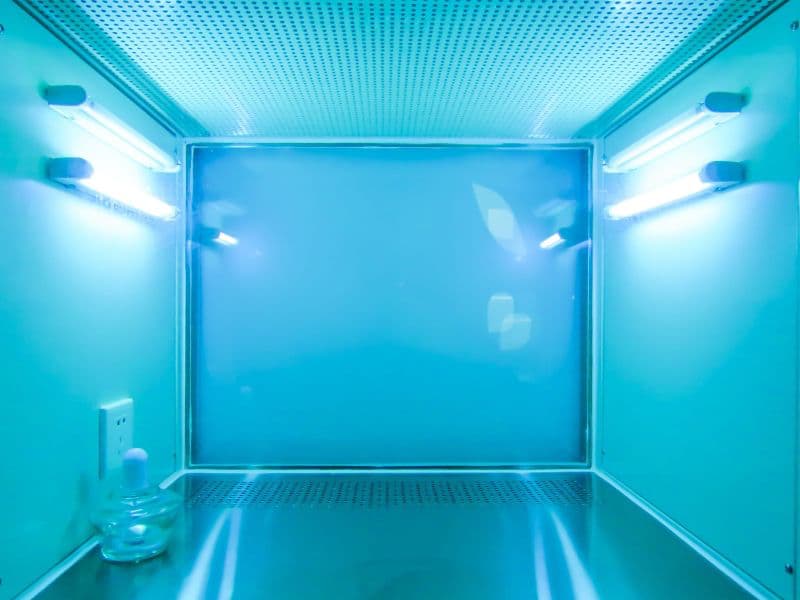Ultraviolet (UV) light is electromagnetic radiation that comes from various sources; the primary source being the sun. This light is always around us. However, it’s difficult to notice it with the naked eye. It has many purposes including killing mold on surfaces such as bathroom walls.
UV light kills mold by sending out short wavelengths of energy that penetrate mold, breaking up its DNA and, in the process, rendering the mold spores inactive. For the best results, UV-C light is the most effective wavelength to kill mold. Mold also kills mildew and other pathogens at home.
Although excess UV light is harmful to our health, this light has many helpful applications. For example, it can be used to detect biological materials at crime scenes. Also, it can kill viruses and bacteria without requiring toxic chemicals. However, many people seek to know if UV light kills mold.

What is UV Light?
UV light is a special light that you can’t notice with naked human eyes. Typically, the sun produces this electromagnetic radiation, but it can be available from other vast sources.
The UV light typically used for killing mold is the UV-C light which has a short wavelength. Due to the multiple helpful benefits of UV light, the light is used to disinfect, including treating ballast water.
It is essential to understand the meaning of UV light due to its multiple uses. For example, you can efficiently use UV light to disinfect water, detect biological materials, and get rid of mold. Compared to regular light, UV has a higher frequency that makes it perforate the skin and is effective for various uses.
Does UV Light Kill Mold?
UV light will kill mold, mildew, and multiple pathogens when used correctly. Though you can use UV light anywhere in your place or home, it is commonly used to get rid of mold in air conditioning units. UV light is mainly used in many industries to kill mold, including black mold.
However, its primary use is decontaminating micro bacteria for air purification, medical, and water treatment. Notably, a short wavelength of UV light will kill germs and mold.
UV is highly effective in killing mold since, when the lamp is used within an environment, the light covers the entire area, disinfecting it. There are other manual methods of cleaning to kill mold. However, they are more time-consuming and less effective.
Installing a UV lamp in an HVAC system will guard the entire area free from mold. Remember, UV effectiveness in killing mold depends on the time the light is exposed and its intensity. Typically, higher intensity UV light is more effective for killing mold than less intensive light.
The Action of UV Light on Mold
UV light produces electromagnetic radiation that can penetrate and disinfect organisms. When you place a UV lamp on short wavelengths, the short light waves kill most mold cells, leaving the remaining cells sterile such that they will be unable to reproduce.
In addition, due to the mold’s fast-spreading nature, UV light effectively prevents mold by preventing spreading and damaging it at once. Mold spores can even clog up shower heads preventing the water from coming out.
The manual approach to killing mold is less effective since you will most likely miss a spot of mold that will reproduce and spread in no time. On the other hand, the UV light will spread over the area quickly, penetrate through the mold cells, and damage nucleic acid, a mold component.
How to Kill Mold with UV Light
When using this process, avoid direct eye contact with the light. You can use special UV glasses that will protect your eyes. Other substandard eyeglasses will not protect your eyesight. Also, ensure you wear gloves when handling the bulb to prevent damage to your skin.
Here is how to kill mold with UV light:
Step 1: Obtain a UV-C Lamp
Obtaining a UV-C lamp is the first step in killing mold with UV light. There are various sizes and types of such lamps that cater to your needs. After purchasing the lamp, you are ready to proceed to the next step.
Step 2: Identify Surfaces Infested with Mold
After you are ready with your lamp, you should identify the surfaces infested with mold fungus. Missing a surface will allow the mold to live and spread all over your living area or business. Thus, be thorough with this identification step.
Step 3: Expose UV Light
Place your UV-C lamp about 2 inches away from the mold to be killed. Turn off all other light sources in the room to ensure that the UV light will kill all the mold. Also, all doors and windows that allow small amounts of light should be closed.
Leave the mold under the UV light for 1-2 hours to kill it completely. Repeat the entire process on any other surfaces where you will likely identify mold.
Advantages of Killing Mold with UV Light
The benefits of using UV light to kill mold include the following:
| Pros | Cons |
| Effective | Needs to be used on all surfaces |
| Kills more mold than alternatives | Needs to be at the right distance |
| No harmful chemicals used | Not instant |
| Kills about 99.9% of mold cells | No long-term effects |
| No special skills needed to use | UV exposure is dangerous |
- More effective in killing mold compared to other methods.
- The method kills more mold than the alternatives.
- Allows you to get rid of chemical-killing alternatives.
- Eradicates about 99.9% of mold cells.
As seen here, it’s an effective yet largely harmless method.
Disadvantages of Killing Mold with UV Light
The downsides to using UV light to kill mold include:
- You will need to use this light on all surfaces that have mold.
- For efficiency, you must place the UV lamp at the right distance to kill all mold cells.
- Doesn’t kill mold instantly and requires to be directed at the surface for a longer period of time than other methods.
- Doesn’t have a long-lasting effect since it only works at the time the mold is exposed to it.
- Can be dangerous since exposure to UV light isn’t safe.
It needs some keenness when using UV light to kill mold. However, it’s not so complex as to deter you from using it.
How to Kill Bathroom Mold with UV Light
Kill mold in your bathroom with UV light as follows:
- Keep your bathroom free from moisture: Before starting the control process, ensure your bathroom’s moisture level is at 50% or below. This will ensure that the environment is unfriendly for mold to thrive.
- Get the UV-C lamp: There are various lamps for killing mold. However, they will produce various efficiencies and wavelengths. Therefore, for optimum results, the UV-C lamps will be the best.
- Identify mold surfaces in your bathroom: You need to identify the areas in your bathroom infested with mold. Failure to identify a surface will leave mold to spread all over your bathroom after the treatment.
- Expose the mold to UV light: For the best results, ensure you place the UV lamp two inches away from the wall. You should keep the doors, windows, and other light sources shut. Leave the mold surface under the UV light for 1-2 hours.
Repeat this process on all the walls until you get rid of all the mold. Done right and enough times, mold spores will die off from this procedure.
How to Control Mold Spread in Your Home
To keep mold from your home, take the following steps:
- Maintain low humidity levels: Moisture facilitates the growth and spread of mold. For safety, always maintain a humidity level of less than 50% to make the environment unsuitable for mold. Also, leave the shower window open after each shower.
- Ensure proper ventilation: Make sure your home has sufficient ventilation. Install an air conditioner, circulating fan, and a cloth dryer vent outside.
- Seal possible leakages from roofs and plumbing walls to avoid moisturizing those surfaces.
- Clean your home within 48 hours after it gets flooded.
- Paint walls with mold-repellent paint to prevent molds.
- Use mold-killing agents to clean your kitchen and bathroom.
- Avoid using carpets in areas in your house that have high moisture levels.
- Replace or remove moist furniture and rugs that can’t dry to prevent mold infestation.
- Give enough time for tiles to set before grouting to eliminate spaces in the tiles that might lead to mold growth.
With mold, it’s always better to prevent it than fight it off. With these steps, it’s quite easy to keep it at bay. Mold can even clog up toilet flappers making it hard to use the toilet.
Bottom Line
UV is mold-killing light. You can get UV-C lamps for the best mold-killing experience in your home and especially in the bathroom. When using this method, always follow the outlined precautions and necessary steps to kill mold.
In addition to that, you can use UV light for purposes such as detecting biological organisms and medical purposes. Notably, UV light kills mold on a large surface with more efficiency alongside other benefits. Use UV light to kill mold now!
References
Iowa State University. Using Ultraviolet Light as a Way to Control Powdery Mildew.
Cornell University. UV light vs. powdery mildew.
Cornell University. UV light may be ripe to replace chemicals in fungus fight.
